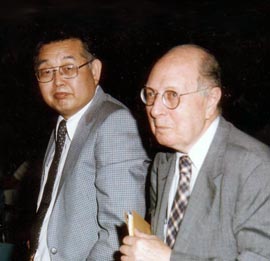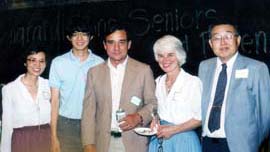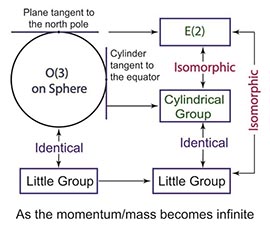Y. S. Kim's Wigner Page

|
| with Wigner (1986) with Treiman (1987) |

|
I met Eugene Paul Wigner in Princeton while I was a graduate student. He was a professor there. He was on my qualifying oral committee at the beginning of my second year in September of 1959. Wigner of course asked an unusual question.
- He asked me whether I can produce the numerical value of the
neutron-proton scattering cross section in the low-energy limit, just
from my memory without reasoning. I said 20 barns. He became very happy,
and told me the exact number is 18. He started liking me, and I went to
him whenever I was confused.
Yet, my thesis advisor was Sam Treiman. He was a young man and an excellent teacher. I wrote my thesis on dispersion relations which every bright had to study at that time. While working on my thesis, I had a question about the Lorentz covariance. I asked Wigner about the Lorentz frame with a fixed four-momentum. He said there are three degrees of freedom once the momentum is fixed.
- His reasoning was that there are six degrees of freedom in the Lorentzian
world, consisting three rotational and three boost degrees. Since the
fixed momentum eats up three of them, there are only three degrees of
freedom left.
I used this aspect in my thesis, but I did not realize Wigner was
talking about his 1939 paper on his little groups
dictating the internal
space-time symmetries of particles in the Lorentz-covariant world.
-
After 30 years, with Noz and Oh,
I published my first paper on the
representation of Wigner's little groups using harmonic oscillator wave
functions. I needed a wave function that can be Lorentz-boosted
in order to show that the quark model and the parton model are two different
manifestation of one covariant entity, as indicated in the third row of the
following table.
Further contents of Einstein's E = mc2Massive/Slow between Massless/Fast Energy
MomentumE=p2/2m Einstein's
E=(m2 + p2)1/2E=p Helicity
Spin, GaugeS3
S1 S2Wigner's
Little GroupS3
Gauge Trans.Internal
Space-timeGell-Mann's
Quark ModelCovariant
OscillatorsFeynman's
Parton Model
- In 1953, together with Inonu, Wigner published a paper on
group contractions.
Isaac Newton showed that a straight line tangential to a curve
can play an important role in physics. How about a tangential
plane on a curved surface. Inonu and Wigner addressed the question
of a plane tangent on the north-pole of a sphere. They showed how
the Galilean transformation emerges from the Lorentz transformation
in the limit if slow speed.
Here is a review paper by Inonu.
- Using this concept of group contractions, with Han and Kim in 1983,
I published a paper in the Phys. Lett. B showing that the transverse
rotational degrees become a gauge degree of freedom, as indicated
in the second row of the above table.
In 1986, with Marilyn Noz, I published a book entitled "Theory and Applications of the Poincaré Group." We completed tha manuscript in 1985. Here is a review of the book.
- Indeed, by 1985, I was prepared to tell Professor Wigner the stories he
wanted to hear. I went to Princeton every two or three weeks to work
with Wigner, and we together published seven papers. This is the reason
why I am known as Wigner's youngest student.
This page was prepared by Y. S. Kim, Center for Fundamental Physics, University of Maryland, College Park, Maryland, 20742, U.S.A.
http://www2.physics.umd.edu/~yskim